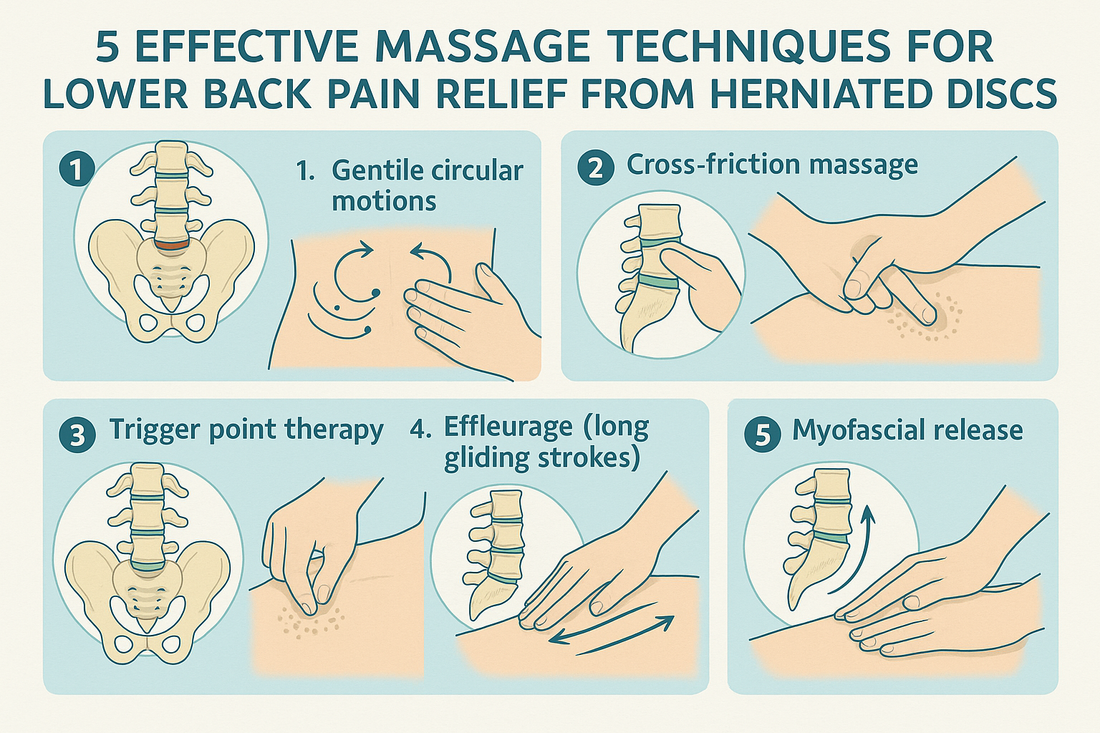
5 Effective Massage Techniques for Lower Back Pain Relief from Herniated Discs
Share
Lower back pain caused by a herniated disc can be debilitating, causing discomfort, stiffness, and limited mobility. When done correctly, massage therapy can help alleviate pain, reduce muscle tension, and improve circulation. Always consult a doctor before starting any massage for a herniated disc. Below are five safe and effective massage techniques to help manage your lower back pain.
1. Swedish Massage: Gentle and Soothing
What is it?
Swedish massage uses soft, flowing strokes to relax muscles and promote overall relaxation. For herniated discs, it’s applied with light pressure to avoid aggravating the condition.
How to Do It:
-
The therapist uses circular motions with fingertips or palms on both sides of the lower back.
-
Movements are gentle, avoiding direct pressure on the spine.
-
Massage oil is used to reduce friction and enhance comfort.
Benefits:
-
Improves blood flow.
-
Reduces muscle spasms.
-
Promotes relaxation and stress relief.
At-Home Tip:
Ask a partner to perform gentle strokes on your lower back, or use your hands with massage oil for self-massage.

2. Trigger Point Therapy: Targeting Pain Points
What is it?
Trigger point therapy focuses on tight muscle knots (trigger points) that often contribute to pain radiating from a herniated disc.
How to Do It:
-
Identify tender spots in the lower back or hips.
-
Apply gentle pressure with fingertips to these points for 30-60 seconds.
-
Ensure pressure is tolerable and avoid the spine directly.
Benefits:
-
Releases muscle knots.
-
Reduces referred pain.
-
Relieves localized tension.
At-Home Tip:
Use a tennis ball against a wall to gently roll over trigger points in your lower back.

3. Deep Tissue Massage: Intense but Controlled
What is it?
Deep tissue massage targets deeper muscle layers to address chronic tension. For herniated discs, it must be performed cautiously by a professional.
How to Do It:
-
A therapist uses slow, firm pressure on the lower back muscles, avoiding the spine.
-
Massage oil helps reduce friction.
-
Focus is on deeper tissues without causing discomfort.
Benefits:
-
Relieves chronic muscle tension.
-
Enhances circulation.
-
Improves range of motion.
Caution:
This technique should only be done with a doctor’s approval due to the intensity. Avoid at-home attempts without professional guidance.

4. Myofascial Release: Freeing Connective Tissue
What is it?
Myofascial release targets the fascia, the connective tissue surrounding muscles, which can become tight in herniated disc cases.
How to Do It:
-
The therapist applies gentle stretching and pulling motions to the lower back and hips.
-
Slow, sustained movements loosen the fascia.
-
Can be combined with light stretching exercises.
Benefits:
-
Reduces fascial tension.
-
Improves flexibility.
-
Alleviates pain.
At-Home Tip:
Use a foam roller to gently roll along the sides of your lower back for a similar effect.

5. Hot Stone Massage: Warmth for Relaxation
What is it?
Hot stone massage uses heated stones to relax muscles and improve blood flow, providing relief for herniated disc discomfort.
How to Do It:
-
Smooth, heated stones are placed on the lower back.
-
The therapist uses the stones to perform gentle circular motions.
-
The warmth enhances the massage’s relaxing effects.
Benefits:
-
Deeply relaxes muscles.
-
Boosts circulation.
-
Reduces stress and tension.
At-Home Tip:
Place a warm (not hot) towel on your lower back for a similar soothing effect. Consult a professional before using stones.

Precautions
-
Consult a Doctor: Herniated discs are serious; get medical clearance before massage.
-
Avoid Excessive Pressure: Direct pressure on the spine can worsen symptoms.
-
Choose a Qualified Therapist: Work with someone experienced in herniated disc care.
-
Test Oils for Allergies: Always patch-test massage oils on your skin.
Conclusion
These five massage techniques can help manage lower back pain from herniated discs, whether done professionally or adapted for home use. Pair with gentle stretching for optimal results. Explore these methods to find what works best for you, and always prioritize safety.